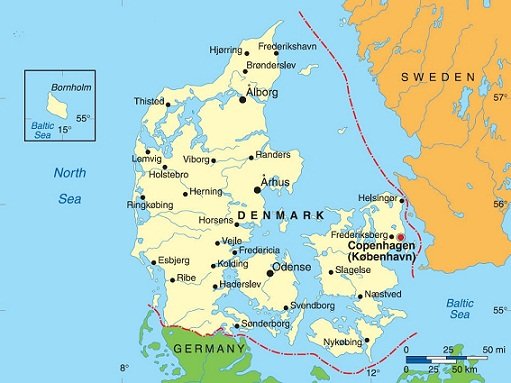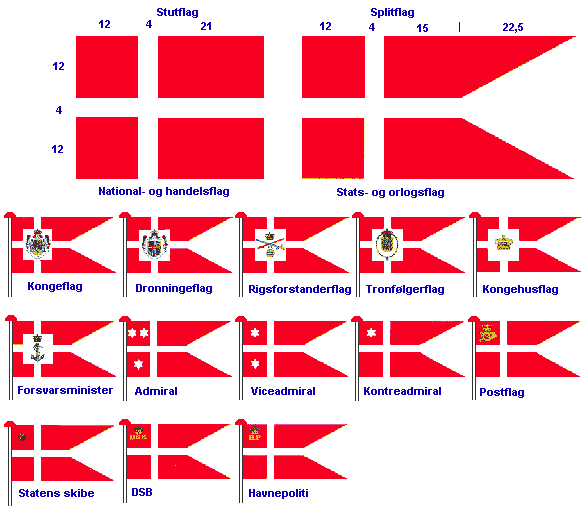
LIDT OM KONGERIGET DANMARK
ABOUT THE KINGDOM DENMARK
DANMARK

Gammelt kongerige.
Areal 43.075 kvadratkilometer fordelt på halvøen Jylland og ca. 433 navngivne øer. Ca. 5,2 mil. indbyggere. Kystlinien er 7.314km. lang
Færøerne og Grønland er medlem af det danske rigsfællesskab.
The surface area of Denmark is 43,075 square kilometers, comprising the peninsula of Jylland and 433 named islands. The total population is about. 5.5 million. The total coastline is some 7,314 km. long.
The previous colonies, the Faroe Islands and the biggest island in the world, Greenland, are now members of the Danish Community. Both have extensive self government, and two members each in the Danish Parliament.
Denmark has a temperate coastal climate. It is surrounded by water and close to greater sea areas, and the Atlantic Golf Stream causes a mild wind from west for most of the year.
About. 86% of the Danes are Lutheran Protestants, and are members of the "folkekirken" (The Church of the People), but only a few of them regularly go to church.
Surnames:DENMARK

An old Kingdom, with Queen Margrethe II on the throne since 1972.
The Queen has no political power or influence, but has a position as Head of the State, and represents the country as constitutional monarch. The main residence of the Royal Family is Amalienborg Castle in the capital, Copenhagen.
The political leader if the Parliament is called Statsminister, (Minister of State=Prime Minister)
The Danish parliament is the previous Royal Castle of Christiansborg, in the capital which has some 1,1 million inhabitants. The Parliament is called 'folketinget' (People' Parliament).
The average temperture in summertime (June-Sepember.) is about. 20C, and in wintertime (November-March), about. 0C. The winters are often "green" with only a
The folkekirke is a church of state, and people have to resign if they don't wish to be members, and pay church taxes. All religions and sects are free to practice in the country (about. 60 at the moment).
Many churches are built abt. year 1.100. Graveyards are normaly placed around them. Coffin burials may not be disturbed in 20-25 years. If the family do not pay for a longer period, another can be burried on the same place. Burial urns after 10 years.
Surnames ending with ...sen - Jensen, Petersen, Rasmussen, Hansen, Sørensen etc., are not necessarily related. Until abt. 1850 children didn't have the same surname as their father. When a girl married, she got her husbonds surname. Their childrens surnames was constructed from their father's firstname plus sen (son) , or datter (daughter). Peter Jensens son could f.ex. be called Jens Petersen. (Jens Peters-son).
In 1826 it was by law decided, that the girls should have the same surname as their brothers and not longer be called ...daughter and in 1856, that they should keep the surname they got after 1826 as surname for the future, and not longer change for each generation.
It took several years before the law was implemented.
Today, surnames with ending ..sen, are not so dominating as before and the danes almost can take the surname they wishes.
Only a few family names s are protected.
DANNEBROG
Betegnelsen på det danske nationalflag, der er et af verdens ældste. Sagnet fortæller, at da Valdemar II med tilnavnet Sejer, drog på erobringstogt til Estland i året 1219, dalede det under et slag den 15. juni, hvor det var ved at gå danskerne dårligt, ned fra himmelen, og vendte sejrslykken. 15. juni kaldes derfor også Valdemarsdag. Det første sikre vidnesbyrd om flagets eksistens, stammer fra Valdemar Atterdags tid (1340-1375). Det ældst kendte dannebrog stammer fra Erik af Pommerens tid (1397-1439). Flaget findes i forskellige udformninger:
The name of the Danish National Flag, which is one of the oldest national flags in the world. Legend has it that king Valdemar II, called Valdemar the Victorious, was on a conqueroring expedition in Estonia in the year 1219. During a great battle, where the Danes were in retreat, the flag came falling from the sky, and at the same time, the fortune of the battle changed, and the Danes won.
The first secure testimony for the existence of the banner comes from King Valdemar Atterdags time (1340-1375). The oldest known Dannebrog is from King Erik of Pomerania's era (1397-1439). The banner exists in different forms.
DANNEBROG
 |
|
|
© Erik F. Rønnebech, Landlystvej 5B, DK - 7000 Fredericia, Tlf:+45 2099 3286